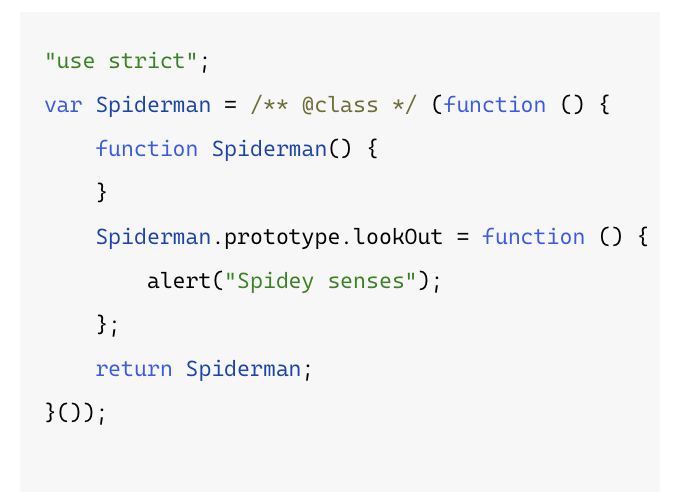-
Star
(108)
You must be signed in to star a gist -
Fork
(8)
You must be signed in to fork a gist
-
-
Save gaearon/a25fd42a1e6b4cc24851978df0a36571 to your computer and use it in GitHub Desktop.
| class Spiderman { | |
| lookOut() { | |
| alert('My Spider-Sense is tingling.'); | |
| } | |
| } | |
| let miles = new Spiderman(); | |
| miles.lookOut(); |
| // class Spiderman { | |
| let SpidermanPrototype = { | |
| lookOut() { | |
| alert('My Spider-Sense is tingling.'); | |
| } | |
| }; | |
| // let miles = new Spiderman(); | |
| let miles = { __proto__: SpidermanPrototype }; | |
| miles.lookOut(); |
function Spiderman() {} Spiderman.prototype.lookOut = function() { alert('My Spider-Sense is tingling.'); }Same?
Not really unless you use the new operator (new Spiderman). Under the hood, 4 things happen:
- A brand new object is created
- That object's prototype is set to the prototype property of the function you're newing up.
- The "constructor" function (ie. Spiderman) is called with the "this" context set to the brand new object in step 1.
- The brand new object in step 1 is returned (there is an edge case but it's something dumb).
Dan's example is the simplest and the most accurate though, imo.
`
// class Spiderman {
let SpidermanPrototype = {
lookOut() {
alert('My Spider-Sense is tingling.');
}
};
// let miles = new Spiderman();
let miles = { proto: SpidermanPrototype };
miles.lookOut();
`
Alot more clear for my head to remember...
@abdullahsari thanks, that jogged my memory. I remember reading that in YDKJS.
Did a bit more digging as the code I had written was something I remembered a long time ago. See YDKJS
I was curious how TypeScript/babel transpile classes and discovered they pretty much use the same method except babel does more checking and property descriptor setting.
Love this content, thank you for sharing it freely with us all Dan!
@ovistoica typescript is probably converting it like that for compatibility and performance reasons. But people are discouraged to use it.
@ovistoica I think it is not exactly polluting, because It isn't changing a default prototype like Array, String or Object ones.
Hi @gaearon,
I am wondering why, when defining classes, the properties are on the object itself while the methods are on the __proto__
class Spiderman {
aProperty;
lookOut() {
alert("My Spider-Sense is tingling.");
}
}
let miles = new Spiderman();
console.log(miles.hasOwnProperty("aProperty")); // true
console.log(Object.getPrototypeOf(miles).hasOwnProperty("lookOut")); // true

This is picked up from the Typescript playground. I just finished the Just Javascript module written by Dan and I have a question which might be a noob one but isn't
Spiderman.prototype.lookOut = (..)regarded as polluting the prototype and should be discouraged?
const someObject = {};
const everyObjectProto = someObject.__proto__;
const someFunction = function() {};
someFunction.prototype.__proto__ === everyObjectProto; // true
So "someFunction.prototype" points to an object, just like any other in your code, not to the "main" object prototype. Thus it is not polluting anything.
This is picked up from the Typescript playground. I just finished the Just Javascript module written by Dan and I have a question which might be a noob one but isn't `Spiderman.prototype.lookOut = (..)` regarded as polluting the prototype and should be discouraged?
const someObject = {}; const everyObjectProto = someObject.proto; const someFunction = function() {}; someFunction.prototype.proto === everyObjectProto; // true
So "someFunction.prototype" points to an object, just like any other in your code, not to the "main" object prototype. Thus it is not polluting anything.
This someFunction.prototype.__proto__ === everyObjectProto; // true can be changed to someFunction.prototype === everyObjectProto; // false for clarity
Thanks for the comment @rahildar! I've fixed it, check out the edit.